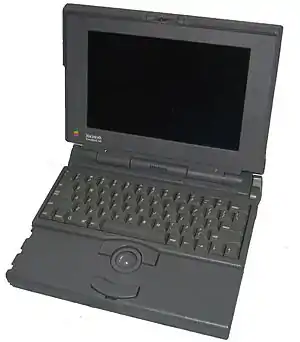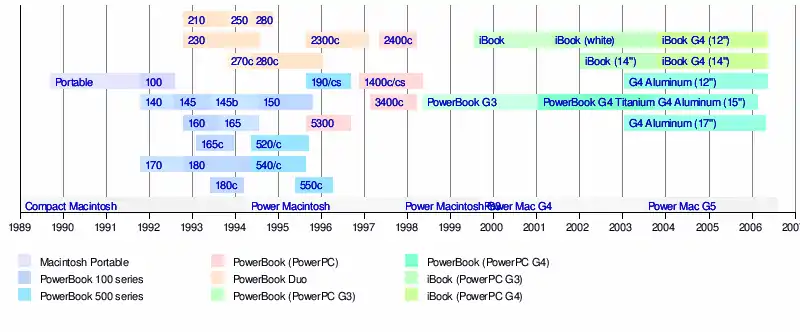PowerBook 140
The PowerBook 140 was released in the first line of PowerBooks. It was the mid-range PowerBook, between the low-end 100 and the high-end 170. As with the PowerBook 170, and unlike the 100, this PowerBook featured an internal floppy drive. Codenames for this model are: Tim Lite, Tim LC, Replacements, and Leary. In 1992, it was replaced by the PowerBook 145, which was essentially a speed bump, though the PowerBook 160 essentially superseded it as the new mid-line model.
 Apple Macintosh PowerBook 140 | |
| Developer | Apple Computer |
|---|---|
| Product family | PowerBook |
| Type | Laptop |
| Release date | 140: October 1991 145: August 1992 145B: July 1993 |
| Introductory price | 140: US$3,199[1] 145: US$2,999 145B: US$1,649 |
| Discontinued | 140: August 1992 145: June 1993 145B: July 1994 |
| CPU | 140: Motorola 68030, 16 MHz 145B: Motorola 68030, 25 MHz |
| Predecessor | Macintosh Portable Powerbook 100 |
| Successor | PowerBook Duo |
Features
Intended as a replacement for the Portable, the 140 series was identical to the 170, though it compromised a number of the high-end model's features to make it a more affordable mid-range option. The most apparent difference was that the 140 used a cheaper, 10 in (25 cm) diagonal passive matrix display instead of the sharper active matrix version used on the 170. Internally, in addition to a slower 16 MHz processor, the 140 also lacked a Floating Point Unit (FPU) and could not be upgraded. It also came standard with a 20 MB hard drive compared with the 170's 40 MB drive.
The 140 was introduced with System 7.0.1, specifically to support new power management and other unique hardware features. However, due to the RAM prices in 1991, combined with its already high list price, the 140, like the 100 and 170, only had 2 MB RAM soldered directly onto the logicboard, which critics felt was restrictive for use with System 7. Furthermore, since localized versions of System 7 were not yet available worldwide, the Japanese 6.0.7 KanjiTalk version of Apple's System software, was modified to support all three new PowerBooks and released as version J-6.0.7.1.[2][3] As a result, this version was unofficially adapted for use with the standard 6.0.7 allowing many users to run System 6 on their PowerBooks, rather than upgrading on-board RAM with an expensive proprietary RAM card (a 2 MB card was US $300).[4]
Design
Though released at the same time as the PowerBook 170 and PowerBook 100, both the 140 and 170 were designed entirely by Apple, while the 100 was miniaturized by Sony from the full-sized Macintosh Portable. As a result, the 140 represents the very first notebook computer created by Apple, with the 100 actually representing the first design improvements, though its internal architecture is the oldest in the series.
It was replaced by the PowerBook 145B in June 1993. The only codename for this model is: Colt 45.
PowerBook 145B
The PowerBook 145B was the same as the PowerBook 140#PowerBook 145 that came before it, but with a lower price and additional 2 MB of RAM soldered to the motherboard. The only codename for this model is Pikes Peak.
Unlike previous Mac models but like the Performas, the 145B did not ship with a full set of system disks. System 7.1 was preinstalled on the internal hard disk, and a single system startup disk was included. The package also included two utilities that provide basic backup and restore functions. Although the 145B shipped with System 7.1, it can, in fact, run System 7.0.1, however it will incorrectly report as a 140 in “About This Macintosh...”
The 145 was superseded by the PowerBook 150 as the next low-end PowerBook.
Specifications
| Component | 140 | 145 | 145B |
|---|---|---|---|
| Processor: | Motorola 68030, running at 16 MHz | Motorola 68030, running at 25 MHz | Motorola 68030, running at 25 MHz |
| RAM: | 2 MB on board, can be expanded to 8 MB | 2 MB on board, can be expanded to 8 MB | 4 MB on board, can be expanded to 8 MB |
| ROM: | 1 MB | 1 MB | 1 MB |
| Hard disk: | 20-80 MB | 40-120 MB | 40-120 MB |
| Floppy disk: | 1.44 MB Superdrive | 1.44 MB Superdrive | 1.44 MB Superdrive |
| Systems supported: | System J-6.0.7.1, System 7.0.1-Mac OS 7.6.1 | System J-6.0.7.1, System 7.0.1-Mac OS 7.6.1 | System 7.1-Mac OS 7.6.1 |
| ADB: | Yes (1 port) | Yes (1 port) | Yes (1 port) |
| Serial: | Yes (2 ports) | Yes (2 ports) | Yes (2 ports) |
| Modem: | optional (used for this model's expansion port) | optional (used for this model's expansion port) | optional (used for this model's expansion port) |
| Screen: | passive matrix, 1bpp 640×400 | passive matrix, 1bpp 640×400 | passive matrix, 1bpp 640×400 |
Timeline of PowerBook and iBook models

References
- LePage, Rick (October 22, 1991). "PowerBooks: price-competitive and technologically brilliant". MacWEEK.
- System J-6.0.7.1 ReadMe, 1991, Apple, Inc.
- http://apple.ism.excite.co.jp/page/漢字Talk+6.0.7.html
- "System 6 on a PowerBook 140/170". Archived from the original on September 7, 2008. Retrieved May 31, 2008.
External links
- Apple.com's PowerBook 140 specifications
- apple-history.com's section on the PowerBook 140
- PowerBook 140 at The Computer Resource
- A prototype PowerBook 140.
- "PowerBook 145B, 360 degree model", Russian Vintage Laptop Museum (museum)